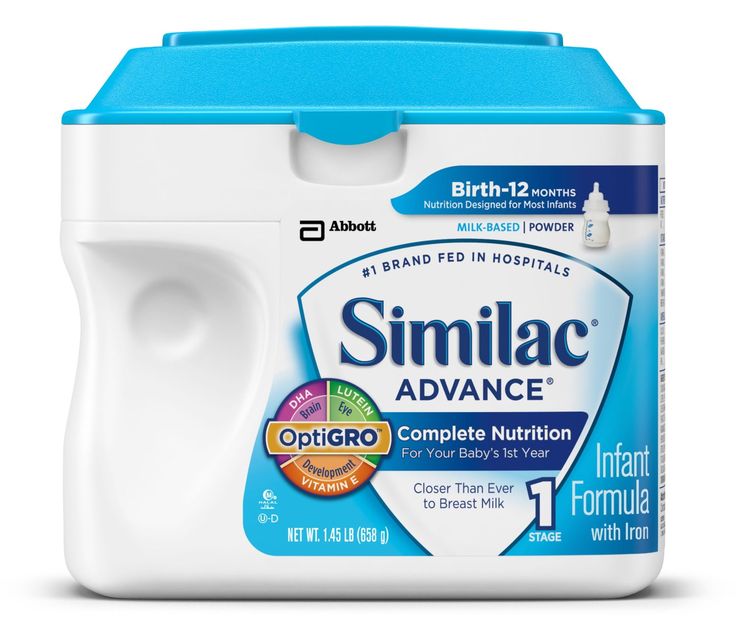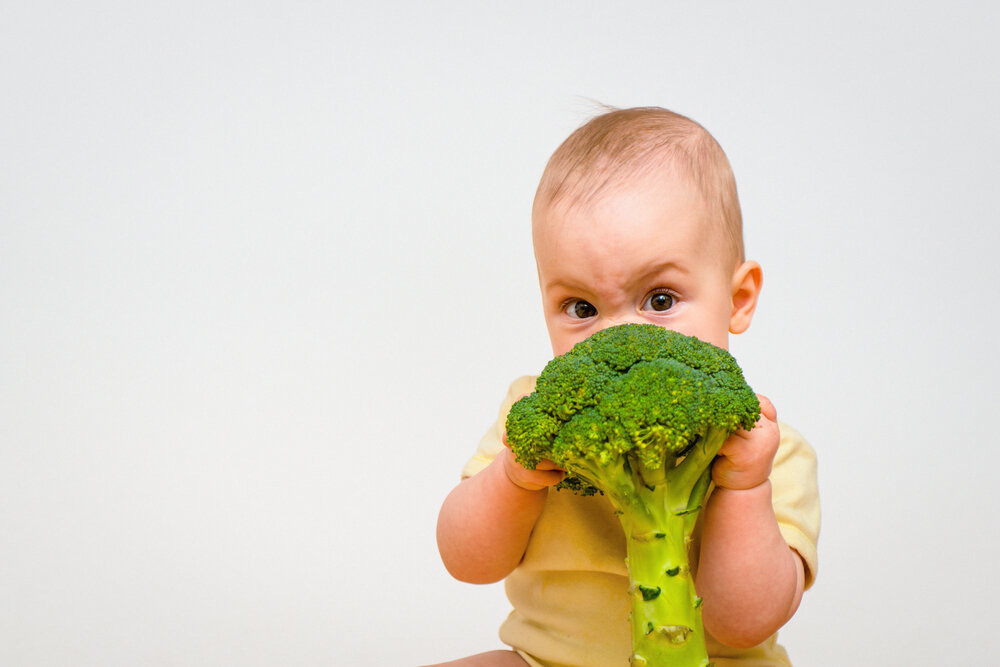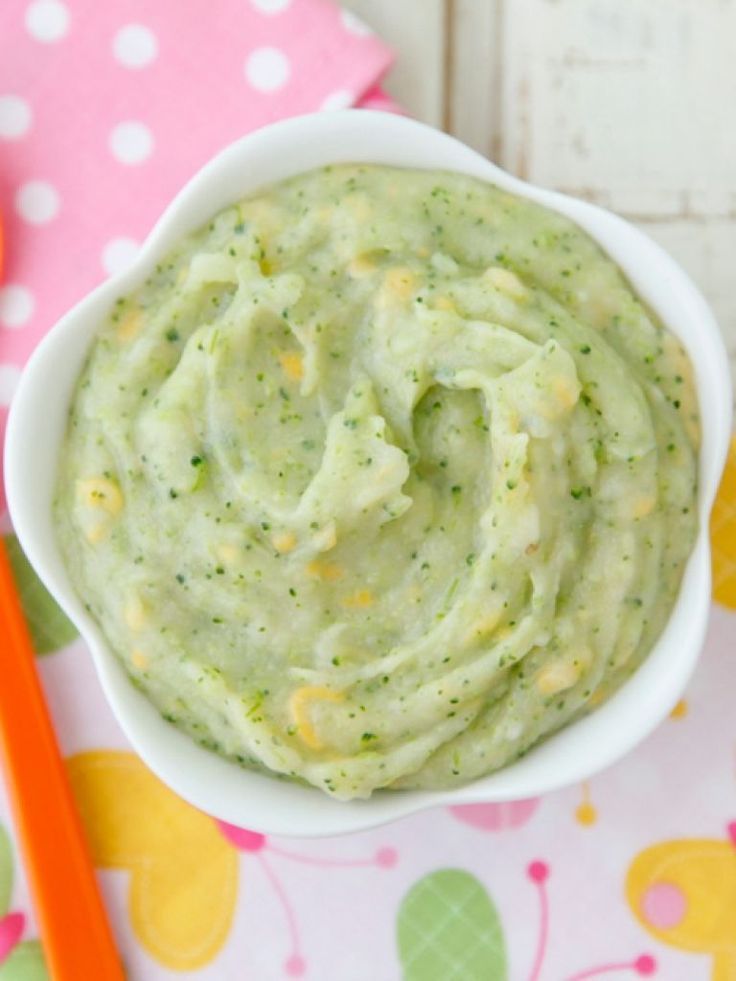After 9 month baby food
Foods, Tips, and Meal Plan for Feeding Your 9-Month-Old
By the time your baby is 9 months old, they have likely been eating solid foods in addition to either breast milk or formula for a few months.
It can be overwhelming deciding what foods to feed your little one, especially when you’re most likely already busy babyproofing and soaking up all the new and exciting milestones.
This article provides an overview of some of the best foods for your 9-month-old, as well as which foods are best avoided so that you can help your baby get all the nutrients they need.
Even though your 9-month-old is eating food, their main source of nutrition should continue to come from either breast milk or formula. Any additional foods can be considered complementary until your baby turns 1 (1, 2).
Some parents choose to begin with puréed foods when first starting solids, while others may opt for a baby-led weaning approach, which involves offering foods in their solid form with an emphasis on allowing babies to feed themselves (3).
If your baby eats purées, the American Academy of Pediatrics (AAP) recommends beginning to offer foods with varying textures and some more solid foods that help a baby learn how to chew around 8 months of age (2).
Some great foods to offer your 9-month-old baby include:
- Fruits: bananas, soft pears, peaches, watermelon, cantaloupe, strawberries
- Vegetables: soft-cooked broccoli, carrots, green beans, sweet potatoes
- Protein: eggs, soft-cooked or ground meat, tofu, smashed beans, low mercury fish
- Healthy fats: avocado, fish, olive oil, nut butters
- Iron-containing foods: eggs, meats, fish, iron-fortified cereals, whole grain bread or pasta
Key nutrients for baby
Offering a variety of foods will provide your baby with a variety of important nutrients, some of which are especially important for healthy growth and development.
Vitamin D plays an important role in bone health and may help build strong immune systems in babies, though more research is needed on the latter.
Infant formulas are typically fortified with vitamin D, but it’s often recommended that breastfed babies take a supplement of 400 IU of vitamin D per day for their first year of life (4, 5).
Because babies experience such rapid growth in the first year, they’re at a high risk of an iron deficiency, which can lead to serious health outcomes.
Iron supplementation may be needed after the first 6 months, but it may not be necessary if your baby is getting enough iron-rich food sources regularly or drinking formula, which is typically fortified with iron (5, 6).
Healthy fats, particularly omega-3 fatty acids, are also important for babies and young children. They help promote the development and function of brain, eye, and immune health (7, 8, 9).
SummaryOffering your baby a variety of foods will provide them with a variety of important nutrients, but keep in mind, their main source of nutrition should still be breast milk or formula at this age.

While most foods are OK for babies as long as they are prepared and cut appropriately, some foods should be avoided in the first year. Some foods may cause food poisoning in little ones, and others are considered choking hazards.
Here are some important foods to avoid feeding your 9-month-old (10):
- honey
- raw or undercooked meat, fish, or eggs
- fish containing high amounts of mercury, such as shark, swordfish, and marlin
- added sugars
- salt and high sodium foods
- unpasteurized foods
- potential choking hazards like whole grapes, whole nuts, raw fruits and veggies
You may have heard that babies under 1 year shouldn’t drink cow’s milk. That’s because they should still be drinking formula or breast milk to meet their nutritional needs.
They can have milk mixed into foods, such as oatmeal or smoothies, but you could also use breastmilk or formula.
Babies shouldn’t get added sugar, which can replace more nutritious options. Also, too much sodium may be harmful to their developing kidneys, so it’s best to limit their salt intake (10).
Also, too much sodium may be harmful to their developing kidneys, so it’s best to limit their salt intake (10).
SummaryIt’s important to stay away from certain foods in the first year of life because they can cause food poisoning or choking or may not be the best choices for their developing bodies.
A 9-month-old needs 750–900 calories per day and about 400–500 should continue to come from breast milk or formula (2).
You don’t need to track your baby’s calorie intake, but you may wonder how much to offer at each meal and snack.
Babies will eat when they’re hungry and stop when they are full, so you can let them decide how much they would like to eat.
Your baby will likely show cues of feeling full, such as turning his or her head away from you or pushing food away, and also show signs that they’re hungry, such as opening their mouth for food or getting excited (11).
SummaryA 9-month-old baby needs about 750–900 calories per day.
Be sure to keep up with regular formula or breast milk feedings to help them meet their needs, and let your baby decide when they’re full at meals.
It’s normal for your little one’s appetite to vary day to day. Remember, breast milk or formula should continue to be the main source of nutrition for the first year of life, and babies should be getting about 24 ounces (720 mL) of either daily (2, 12).
You can and should also offer water with meals at this age to encourage proper hydration and help wash down solid foods. At this age, it’s recommended babies get about 4–8 ounces (0.5–1 cup) of water per day (13).
As for other beverages, the AAP recommends sticking to just water and breast milk or formula at this age and avoiding sugar-sweetened beverages and other drinks until 2 years of age. Cow’s milk or soy milk can be introduced after 12 months (13).
Here’s a sample menu for a 9-month-old, including 3 meals, snacks, and breast milk or formula:
Breast milk or formula
6 ounces (177. 4 mL)
4 mL)
Breakfast
- 2–4 ounces (59.1–118.3 mL) of prepared iron-fortified cereal
- a banana or other fruit (you can try cutting it up or mashing and mixing it into the cereal, too)
- about 1 teaspoon of nut butter stirred into the cereal
Snack (optional)
One of the following options:
- soft (or cooked) fruit
- plain, whole milk yogurt
- teething biscuits
Breast milk or formula
6 ounces (177.4 mL)
Lunch
- scrambled egg
- soft-cooked broccoli
- whole wheat toast with mashed avocado (try cutting it into strips for easy self-feeding)
Snack (optional)
One of the following options:
- cubed cheese
- whole milk cottage cheese
- soft (or cooked) fruit
Breast milk or formula
6 ounces (177.4 mL)
Dinner
- soft-cooked shredded chicken (the slow cooker is great for this)
- smashed peas
- roasted sweet potato wedges
- soft (or cooked) fruit
Breast milk or formula
6 ounces (177. 4 mL)
4 mL)
SummaryAbove is a sample menu for a 9-month-old baby. Remember, babies will let you know when they are full, and they may not eat everything offered. It’s important to continue to offer at least 24 ounces (720 mL) of breast milk or formula daily.
Feeding your little one can feel daunting, but there are ways to keep it simple so you don’t have to spend too much time cooking and prepping.
Here are some quick meal and snack ideas for your 9-month-old:
Quick and easy breakfast ideas
- scrambled eggs, or a veggie omelet with soft fruit, and whole wheat toast topped with smashed avocado
- French toast made with 1 egg and a sprinkle of cinnamon, topped with plain whole milk yogurt and no-sugar-added applesauce
- plain, whole milk yogurt or whole milk cottage cheese mixed with soft fruit and Cheerios
- iron-fortified cereals mixed with nut butter and smashed fruit
Quick and easy lunch or dinner ideas
- baby meatballs with mashed potatoes and soft-cooked green beans
- Combine 1 pound (0.
 45 kg) of ground meat with 1 egg and 1/2 cup oat flour (plus any seasoning you’d like, other than salt).
45 kg) of ground meat with 1 egg and 1/2 cup oat flour (plus any seasoning you’d like, other than salt). - Roll the mixture into meatballs and bake or cook them with a little chicken broth in an instant pot or slow cooker.
- Combine 1 pound (0.
- shredded chicken with smashed peas and corn
- whole wheat penne pasta with low sodium marinara sauce
- poached fish with sweet potato wedges and soft-cooked broccoli and carrots
- diced tofu with soft-cooked green beans and smashed chickpeas
Quick and easy snack ideas
- soft-cooked vegetable finger food, such as asparagus, cauliflower, broccoli, carrots, or potatoes
- toast or crackers with smashed avocado
- soft or cooked fruits like banana, ripe peaches, strawberries, or cooked pears
- cubed cheese
- plain whole milk yogurt
- whole milk cottage cheese
- hard-boiled eggs
SummaryFeeding your 9-month-old can be overwhelming and time-consuming.
It’s a good idea to have some go-to ideas in your back pocket for quick and easy meals.
Meal prep
Meal prepping is a great way to save time and set yourself up for an easier week. If you can, try planning some meals ahead of time and doing some cooking in advance so that you can reheat things during the week rather than cooking daily.
By the time your little one is 9 months old, they can eat a lot of what you’re eating. When you prepare a meal for yourself or the rest of the family, see what you can do to make it baby-friendly. Here are some tips:
- Leave the salt out until you portion out your little one’s helping first.
- Cut foods into safe sizes for your baby to consume.
- If you’re using a spicy or high sodium condiment, set aside some food for your baby before adding it in.
- Check the texture of the meal yourself to make sure it’s soft enough for your baby. Pinching a food between your fingers is a great way to see whether they can squish it with their gums.

To reduce their choking risk, cut food small enough for them to grab and bite, but not so small that they can swallow it whole. Some raw fruits and vegetables, like apples and carrots, are also choking hazards because they’re too hard to bite into.
Food safety
It’s important to prepare your little one’s food using safe cooking practices to reduce the risk of foodborne illness.
Wash your hands and switch cutting boards when handling raw meat to avoid cross contamination. Cook meats, fish, and eggs to safe temperatures — 145–165°F (62.8–73.9°C) — depending on the food (14).
Be sure to refrigerate food soon after finishing it to preserve it. It’s also a good practice to date leftovers so you know when to throw them away. Most food lasts a few days in the refrigerator or 1–2 months in the freezer (15).
Allergens
By the time your child reaches this age, you may have already begun to introduce some common allergens, such as peanut butter, eggs, and fish.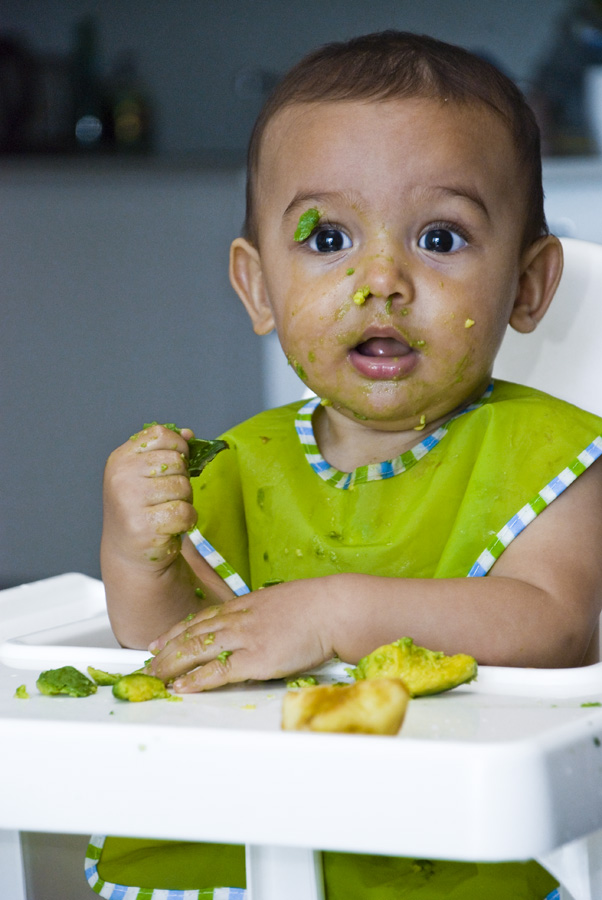 If you haven’t yet, now is a great time, as introducing them earlier on may help prevent an allergy (16, 17, 18).
If you haven’t yet, now is a great time, as introducing them earlier on may help prevent an allergy (16, 17, 18).
It’s a good idea to introduce allergens one at a time and wait a few days in between so that you can monitor your baby for any possible reaction (19).
Signs of an allergic reaction include (20):
- wheezing or coughing
- swelling in the lips or throat
- a runny nose
- itchy skin or a rash
- diarrhea, vomiting, or other signs of stomach upset
If you notice any signs of a mild allergic reaction, such as a rash or upset stomach, call your pediatrician. Call 911 if the symptoms are more severe, such as if you suspect anaphylaxis, which usually involves wheezing, hives, drooling, and drowsiness (21).
Packaged foods
Offering packed foods to your baby can be a convenient way to feed them when you’re short on time. We recommend offering a variety of whole foods whenever possible, but having some packaged items in the pantry can come in handy.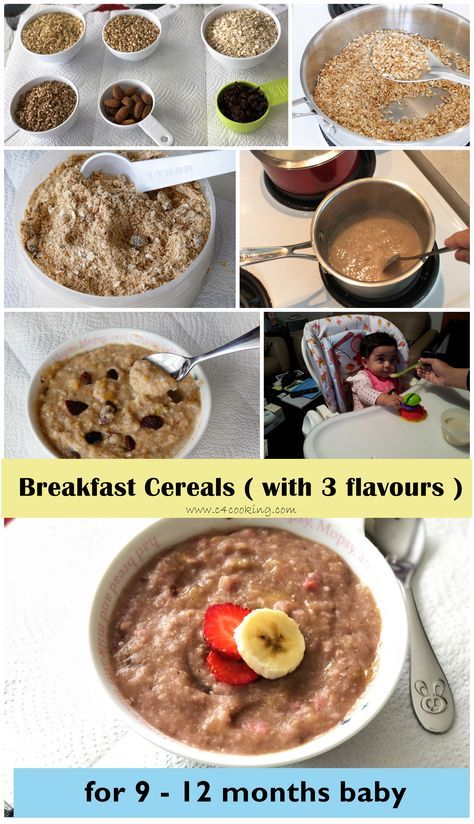
When shopping for packaged baby-friendly foods, look for foods that are low in sodium, added sugars, additives, and preservatives. Additionally, be sure they don’t contain any of the foods that should be avoided in the first year, such as honey.
Lastly, remember that mealtimes should be a fun, low pressure experience. Try not to force your baby to eat more if they are showing signs of feeling full. If they refuse a food, you can try offering it again another time.
Repeated exposure to new foods and maintaining a low stress environment has been shown to promote food acceptance among little ones (22).
SummaryProperly handling, preparing, and storing foods for your baby will help prevent choking and possible foodborne illnesses. Do your best to keep mealtimes fun and relaxed, and let your baby take the lead on how much to eat.
With so many exciting changes and challenges that come with parenting, thinking about and preparing healthy meals and snacks for your 9-month-old baby can feel overwhelming.
By planning ahead and having some go-to meal ideas, you’ll be able to throw together a healthy, balanced plate for your little one in less time.
Preparing some food ahead of time and making your own meal baby-friendly will help save time and the stress of putting together more than one meal.
While 9-month-olds can eat most of the foods you eat, some foods should be avoided, including honey, salt, added sugars, and undercooked or unpasteurized foods.
Properly handling, cooking, and storing your baby’s food will significantly decrease the risk of them experiencing a foodborne illness. Be sure to cut your little one’s food into safe shapes and offer appropriate textures to reduce their choking risk.
Just one thing
Try this today: Combine 1 pound (0.45 kg) of ground meat (chicken, turkey, beef, or pork), 1/2 cup (45 grams) of oat flour, 1 egg, and 2 teaspoons of dried oregano.
Roll the mixture into meatballs and place them on a greased baking sheet in the oven at 400°F (204°C) for 20–25 minutes, or until they’re fully cooked.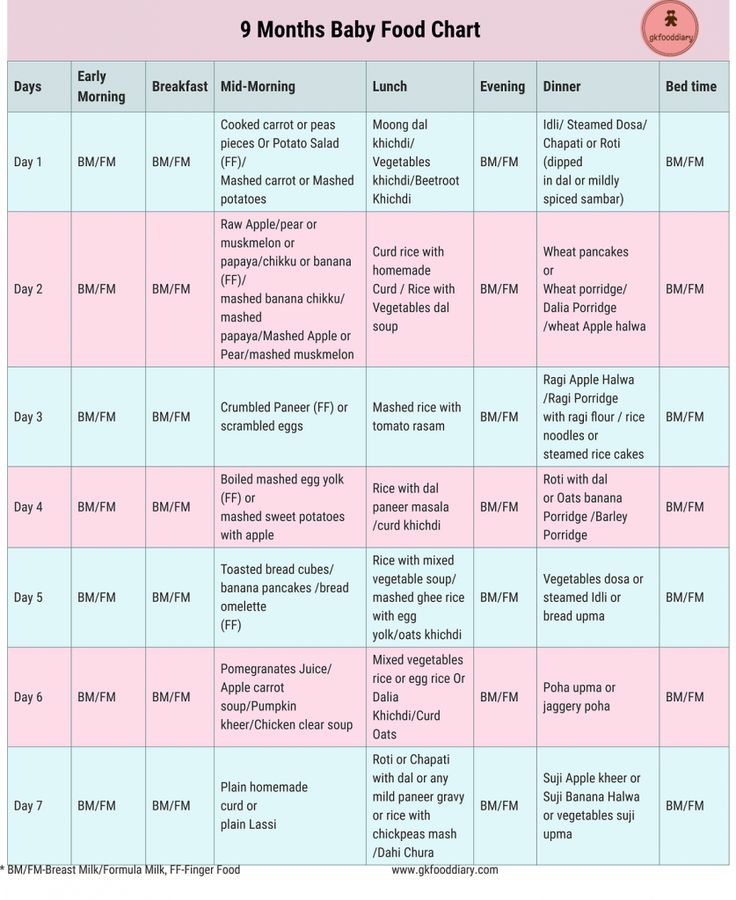
Freeze them and defrost 1 or 2 at a time when you need a quick protein source for your little one.
Feeding schedule with Tasty Recipes
Learn what your 9-month-old can eat and how much, along with continued breastfeeding.
Research-backed
MomJunction believes in providing reliable, research-backed information to you. As per our strong editorial policy requirements, we base our health articles on references (citations) taken from authority sites, international journals, and research studies. However, if you find any incongruencies, feel free to write to us.
Image :Shuttestock
If your baby has already completed nine months and you are looking for some ninth-month-baby food options, you are at the right place. Motherhood is a special phase of happiness and challenges. Though staying up all night, constantly feeding the baby, and changing diapers may seem like never-ending tasks, time flies faster than you realize, and babies grow up in no time.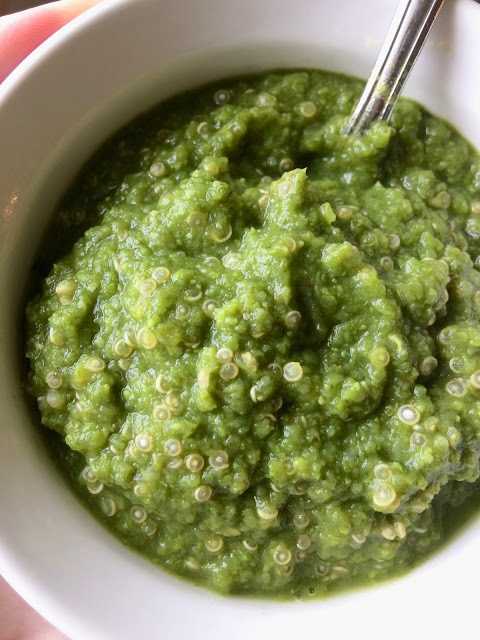
As your baby turns nine months old, they are ready to explore new varieties of food. However, the World Health Organization (WHO) recommends that mothers continue breastfeeding for two years or more. According to the American Association of Pediatrics, mothers should consider breastfeeding for at least one year (1).
Hence, as you start introducing new foods to your baby, do not suddenly stop breastfeeding them. This may harm your baby or make them susceptible to infections. Instead, slowly introduce them to new food and see which ones your baby loves.
Read this post to learn how to wean your baby gradually, the diet requirement of a nine-month-old, and some food ideas for them.
9 Month Baby Food: What to Expect?
Your nine month old has a temperament, attitude, likes and dislikes of her own. She is no longer that cuddly baby who would be content to just lie, gazing at you and your antics at entertaining her. She is now exploring, experiencing and learning new things every day.
The things you can expect by the ninth month are (2)–
- Sitting up without support
- Probably creeping and/or crawling
- Recognizing and remembering Mom and Dad
- Having a special inclination to particular toy, blanket, spoon, plate, song etc.
- Some babies learn to pull themselves up with support (very few in fact)
- Teething
Besides these, each individual baby reaches her own milestones, making it a complete delight to watch their every waking moment and even while they areasleep!
Weaning your Nine-Month Old Baby:
When your baby stops nursing from the breast and starts to eat solid food, it is termed as weaning but we recommend continued breastfeeding for up to two years even after introduction of solids. Friends, relatives and neighbours give various suggestions on weaning but remember that is no right or wrong way to do weaning. You can start weaning your baby when you think it is right, you can also consult the pediatrician/ dietitian.
When the baby starts losing interest in weaning and is distracted or fussy while being nursed you know the time is right to introduce other foods. Generally weaning starts within 6-12 months. When the baby shows the signs of weaning it is called baby led weaning.
If the mother is joining a job post pregnancy then she will have to start weaning. Your child might not be ready for weaning at that point of time so you have to be patient. You can still nurse your child and at the same time introduce solid foods. Mother led weaning can take a lot of time and it also depends on the child’s age and how he is responding to change (3).
So how do you start weaning? The first thing you should remember is not to stop breastfeeding suddenly because this can be traumatic for your baby. You can follow these simple steps to start weaning (4):
a. Skip a Feed:
Offer a bottle of milk instead of breastfeeding. You can give pumped breast milk or whole cow’s milk powder (don’t give this before your child turns one years). Reducing breastfeeding over a period of time allows the baby to adjust to the change. The milk supply of your breasts gradually goes down without causing mastitis.
Reducing breastfeeding over a period of time allows the baby to adjust to the change. The milk supply of your breasts gradually goes down without causing mastitis.
b. Limit Nursing Time:
If you usually nurse your baby for ten minutes then reduce the time to five minutes. Depending on the child’s age give him or her light snack post nursing. You can give unsweetened applesauce or infant milk formula. Babies are not ready for solid food before six months, so after six months solid food is complementary to breast milk till the child turns one year old. It is tough to reduce the time for bedtime nursing because it is last meal of the day for the child.
c. Postpone and Distract:
Try to postpone feedings if you are nursing your baby couple of times a day. This method works if your child understands reason. If your child demands nursing, reassure him that you will and distract him with another activity. So you give the evening feed during bed time.
Breastfed infants need more nutrients than breast milk can provide. The baby needs vitamin D and iron. So along with breast milk you have to provide iron fortified cereals till the child turns one year old (5). Once your baby enters toddlerhood then he will need a wide variety of foods to provide essential nutrients that will help your baby to grow.
If you have started weaning and the child is not responding then it is not the right time. If you have joined work the child is adjusting to the new routine set by you. If the child is unwell then he demands nursing because he finds breast milk comforting and it is a great source of nutrients as well.
Special Dietary Requirements for your Nine-Month Old
A very important event happens around this time – teething! While teething, most babies lose their appetite due to the pain, discomfort and swelling caused by rupturing gums (6). Therefore, it is important to persuade her to eat as much as she can. Do not cave in to her protests and refusals and simply take the easy way out by giving her the bottle – she will miss out on vital nutrients and fiber that her body needs.
Failing to maintain a proper solid diet can make your baby lose weight and also cause long term harm by depriving the brain of nutrients vital to healthy cognitive development (7). Lastly, remember that a child learns life’s eating patterns within the first three years of her life. That is the big picture!
Click here to view an enlarged version of this infographic
9-month-old Baby Food Chart
The following is a sample menu for an 9-month-old feeding schedule as recommended by pediatricians (8). Note that there is a mix of all food types including breast milk and formula:
| Name of the meal | Food items |
|---|---|
| Breakfast | 1/4 – 1/2 cup of baby cereal 1/4 – 1/2 cup pureed fruit 4 – 6 oz.(118 – 177 ml) formula or breastmilk |
| Snack | 4 – 6 oz.(118 – 177 ml) formula or breastmilk 1/4 cup boiled vegetable finger food |
| Lunch | 1/4 – 1/2 cup yogurt or meat or cottage cheese 1/4 – 1/2 cup yellow or orange vegetables 4 – 6 oz. |
| Evening snack | 1 cracker or teething biscuit 1/4 diced fruits or cheese or boiled vegetable finger food |
| Dinner | 1/4 cup diced meat or tofu 1/4 – 1/2 cup cooked green vegetables 1/4 boiled rice or potatoes or noodles or pasta 1/4 cup of diced or pureed fruit 4 – 6 oz.(118 – 177 ml) formula or breastmilk |
| Before bedtime | 6 – 8 oz. (177 – 236 ml) formula or breastmilk. Follow with water and brush teeth later |
Note: Continue to breastfeed your 9-month-old on-demand between meals.
Top 10Â Ideas for 9 Month Baby Food
Choosing food for 9 months baby is very exciting. This is the best time to introduce finger foods (tiny baby bite-sized solid food that the baby can eat on her own). Try these finger food and meal ideas for your temperamental, choosy nine-month old. Remember to mix and match foods according to your baby’s individual likes and dislikes.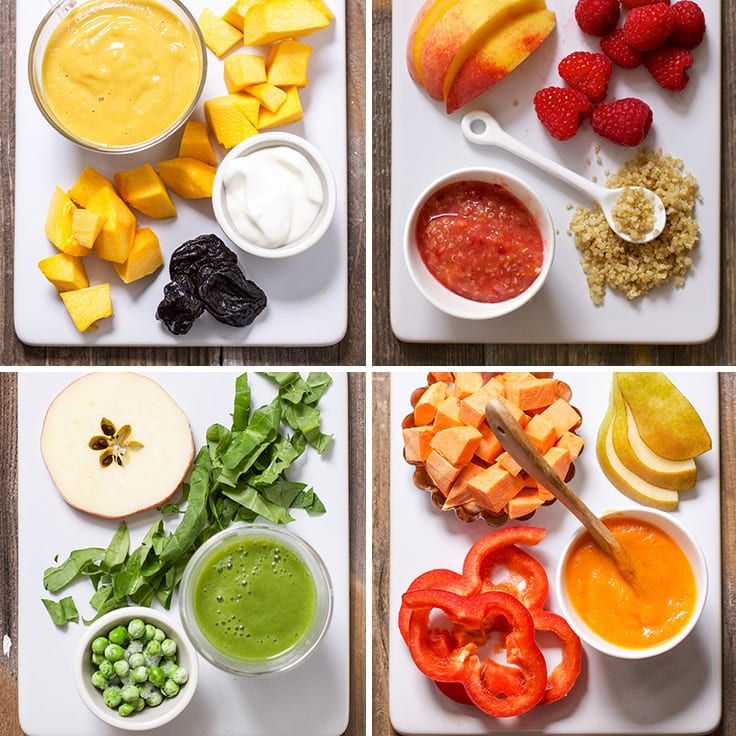
1. Oats:
Talking about 9 month old baby food, including oats is must. If you haven’t yet introduced oatmeal to your baby’s diet, now is the right time to do so. Oats are high in fiber and minerals and low in fats and additives. You can fortify her iron-fortified cereal further by adding oats to it. Inculcating a taste for oats will keep your baby constipation-free for life.
2. Fresh Fruits:
You can add more fruits to the baby’s diet and you need not steam them anymore. Just make sure that the slices you cut don’t get lodged in her throat. Apples, prunes, bananas, pears, mangoes, plums, papayas are all good options to offer as long as the fruit is properly washed, peeled and diced or sliced. Make sure you offer only seasonal fruits.
3. Bread:
You can now safely add all kinds of baked bread to the baby. Allow your baby to choose whether she likes it toasted or untoasted. You can add a smear of butter, cheese or a vegetable puree that suits your baby’s liking.
4. Eggs:
Nature’s nutrition king, eggs, can also be a big part of your baby’s diet, as long as it is properly cooked. Add one egg a day to your baby’s diet in various forms. You can offer her it in the form of an omelette, a mashed boiled egg or simply serve them scrambled hard; let her pick what she likes best.
5. Meats:
Your baby is ready to try meats now. Remember to wash and cook it thoroughly and then dice it into small bits as the baby doesn’t have molars to grind food yet. Chicken, turkey and fish are good sources of protein and vitamins. Mutton can be held off for later, as it is tough to digest. Pork should be totally avoided due to the health risks it poses.
6. Vegetables:
Image: Shutterstock
You can continue to add more vegetables to the baby’s diet and they needn’t be mashed or pureed now. Offer the baby slices or small chunks of cooked cauliflower, carrot, peas, sweet potato, pumpkin, and broccoli. Keep adding to and subtracting from the list, as per your baby’s choices.
7. Roti and rice:
The Indian diet is incomplete without these two staples. Rice is safe for babies since Month 6. You can now introduce her to rotis by peeling off the thinner top layer of the roti, mashing and mixing it with dhal. Most babies love the grainy texture and earthy flavor of this meal.
8. Water and Juices:
It is important to keep offering your baby healthy liquid throughout the day, as she is probably no longer drinking a lot of milk. Besides boiled water, offer her fresh fruit juices like apple, watermelon and carrot. Avoid citrus fruits and fruit juices until age one.
9. Iron-Fortified Cereals:
Commercially available cereals are rich in iron content appropriate for your baby’s age group – something that homemade food might lack. Therefore, add at least one daily serving of an iron fortified cereal to your baby’s diet at least till the age of 18 months.
10. Commercial Baby Milk Powder:
This is a great option as probably by now your baby is too impatient to breast feed and your milk production is also probably low. Commercial baby milk powder has vital age appropriate nutrients that your child cannot afford to miss out on. Ensure that she takes at least two feeds of top feed a day. This way, if she hasn’t had enough to eat, she can get enough nutrients from the bottle.
Infant Formulas for your Nine Month Old Baby:
Image: Shutterstock
If you have already weaned your baby, you can always opt to feed her formula. Infant formula, also known as baby milk powder, is designed to provide the same advantages breast milk does. You can either bottle feed the formula, or mix it in a cup and feed it to your baby as a meal.
American Academy of Pediatrics has laid down guidelines for infant milk formula. There are different types of infant formula, here they are:
- Standard Milk Based Formula: This milk powder is made from protein derived from cow’s milk. Lactose and minerals from cow’s milk is blended with vegetable oils, minerals and vitamins to make it resemble breast milk for the infant’s convenience.
 Most babies suffer from colic but this is not due to cow’s milk formula, and parents don’t need to switch to other formulas.
Most babies suffer from colic but this is not due to cow’s milk formula, and parents don’t need to switch to other formulas.
- Soy Based Formulas: As the name suggests this infant formula is made of soy proteins. The American Academy of Pediatrics recommends soy infant formula if the parents don’t want to introduce animal protein to the baby. Also those babies who suffer lactose intolerance or galactosemia can have soy milk formula. Also soy infant formulas help to deal with milk allergies and colic in babies.
- Hypoallergenic Milk Formulas (Protein Hydrolysate Formulas): These types of milk formulas are suitable for babies who are allergic to milk proteins. Those babies who have rashes and wheezing due to allergies can opt for hypoallergenic milk. This hypoallergenic formula is much more expensive than regular formulas.
- Lactose Free Formula: Lactose deficiency begins in children as early as 12 months and can be detected by using different tests.
 Lactose free formulas should be given to those infants who suffer galactosemia, primary lactase deficiency and congenital lactase deficiency.
Lactose free formulas should be given to those infants who suffer galactosemia, primary lactase deficiency and congenital lactase deficiency.
- Special Formulas: Special formulas should only be used with the permission of the pediatrician. The special formulas are pre-thickened with starch and are needed for infants who have low birth weights and are not gaining proper weight. Special infant formulas contain extra calories and nutrients to meet the needs of the children suffering from health problems like heart disease, malabsorption syndrome, have problems digesting fat and processing some type of amino acids.
There are many new formulas with vague benefits. These can be toddler formulas that help to fill the gaps cause by fussy eating. However, these formulas are not very different from whole milk formulas with multivitamins. These new formulas are also quite expensive. These formulas come in powder form, concentrated liquid form and ready to use form. Just select the milk powder that is best suited for your baby and read the labels and instructions before you purchase the infant milk formulas. It is best to consult the doctor before purchasing the infant milk formula.
Just select the milk powder that is best suited for your baby and read the labels and instructions before you purchase the infant milk formulas. It is best to consult the doctor before purchasing the infant milk formula.
The American Association of Pediatrics (AAP) recommends iron fortified formula for infants who are being breastfed up to 12 months. Infants who drink enough formula milk don’t need any extra vitamins and minerals. The doctor might suggest extra fluoride if the formula is water based and not fluorinated. This infant milk formula can be given to the child till he turns one year (9) (10). AAP does recommended cow’s milk formula to baby below one year. After the child has crossed one year only whole milk formulas should be given and not skimmed or low fat milk.
Some tips to use infant milk powder (11):
- Use sterilized bottles and nipples to feed your baby.
- Don’t make powder watery or extra strong just follow the instructions on the packet or label.

- Store the infant formula in a cool, dry place with a plastic lid on the top. Always wash your hands before using the infant formulas to minimize the chance of infections.
- Once the formula is made store it in individual bottles or in a close pitcher with lid. Feed at least eight bottles per day.
- When you warm the prepared infant formula place it in boiled water, but don’t boil the prepared formula.
- Don’t use the microwave to warm the infant milk formula. Test the temperature of the bottle containing the infant formula before you give it to the baby.
- Hold your child close to you and make eye contact.
- Hold the bottle in such a way that the nipple and the neck of bottle are filled with infant formula so that the baby doesn’t swallow air.
- If the baby couldn’t finish the entire bottle don’t force. Also don’t store the leftover formula, just throw it. Give a fresh formula for each feed.
Foods to Avoid:
- Don’t give your child swordfish or marlin and shark that have high levels of mercury.
 It is harmful for your baby’s central nervous system. Also don’t give your child raw shellfish.
It is harmful for your baby’s central nervous system. Also don’t give your child raw shellfish. - Avoid honey because it causes an infection called infant botulism and is also harmful for the baby’s developing teeth.
- Make sure the egg is cooked thoroughly and both white and yellow is solid.
- Your baby needs high energy foods but not low calorie and low fat foods with high fiber. Though some amount of fiber can be included in the diet.
- Don’t give whole nuts to the baby aged under five it causes choking.
Image: Shutterstock
- Don’t add salt to the baby’s food because the kidneys can’t tolerate it.
- You can add little sugar to the food but don’t make it too sugary. Give fruits with natural sugars but not ice creams, sugary custards, biscuits or sweets that can harm the baby’s developing teeth.
Some Interesting Recipes for Homemade Snacks for Your Nine Month Baby
Mothers have to be really patient and creative in the kitchen if they want their baby to gobble up whatever they serve.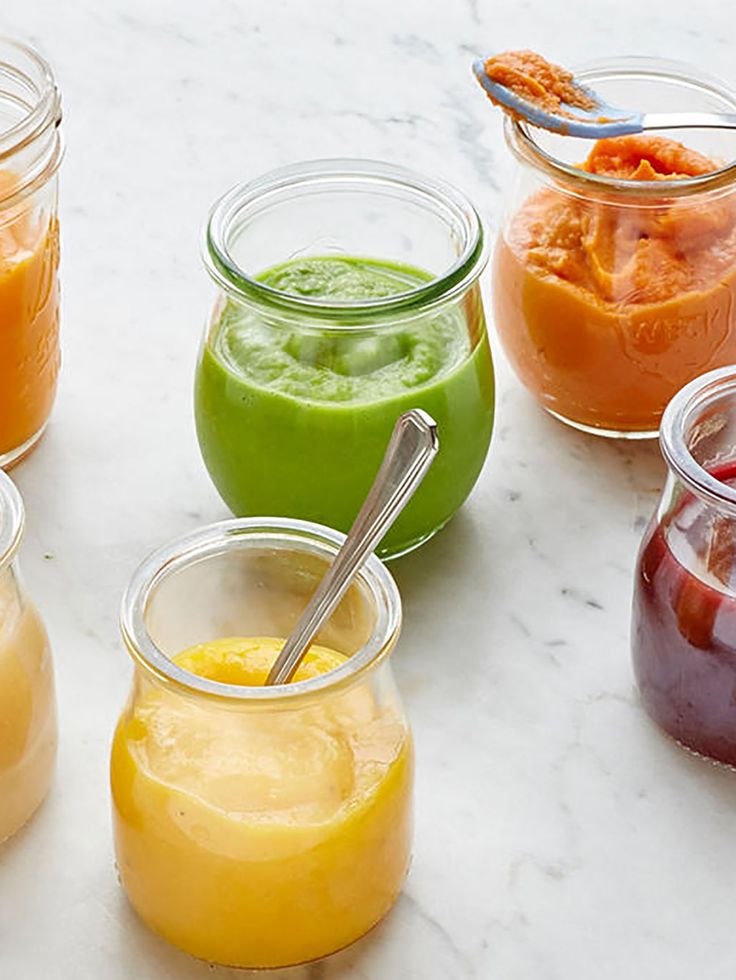 The food served should be tasty and look appealing to the eyes as well. Here are some interesting recipes for snacks that you can make easily at home.
The food served should be tasty and look appealing to the eyes as well. Here are some interesting recipes for snacks that you can make easily at home.
1. Soulful Chicken Soup:
- Dice celery, onion and carrots into quarter inch cubes and keep it aside.
- Heat olive oil in a pot and add chicken pieces (cut into quarter inch into it), sauté until thoroughly cooked for 8 minutes. Set it aside.
- In the same pot add garlic, onion, celery and carrots and sauté until the vegetables are tender.
- Add chicken stock, pasta and frozen peas and simmer till the pasta is thoroughly cooked.
- When the soup cools down blend in a mixer to get the desired consistency.
- Use muffin tray to divide to soup to get the portion size for convenience.
It is best to use homemade chicken stock or if you are purchasing chicken stock cubes make sure it is low sodium.
2. Super Mac and Cheese:
This dish has pumpkin as one of the important ingredient. As we are aware that pumpkin is a super food rich with nutrients and the orange colour blends well with the cheese sauce.
As we are aware that pumpkin is a super food rich with nutrients and the orange colour blends well with the cheese sauce.
- Cook the whole wheat pasta according to the instructions on the packet and drain it, then keep it aside.
- Start making the cheese sauce by melting butter.
- Then add all-purpose flour little by little and then stir thoroughly.
- Remove the pan from heat and slowly add milk and stir till the sauce is thick and coats the back of a spoon. T
- Then add some nutmeg and pumpkin. You can also use butternut squash or sweet potato instead of pumpkin.
- Blend the pasta with the cheese sauce. You can use a hand blender to make the pasta smooth for your little one’s convenience.
- If you are feeding your toddler keep it whole.
3. Zesty Tomato Dipping:
Kids love dipping their food so you can make a healthy and tasty tomato dip at home. This is a versatile dip and you can use it for pizzas and pastas too. You can also serve some chicken fingers along with this yummy dip.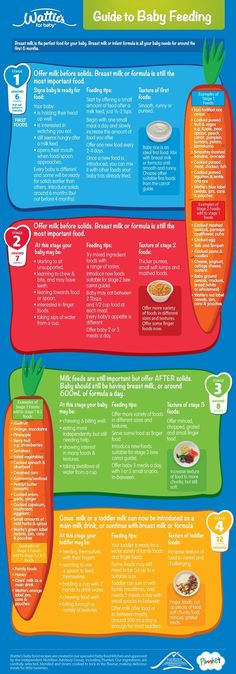
- In a large pot heat olive oil and add a small onion, one minced garlic clove, one finely chopped carrot and one stalk celery finely chopped.
- Sauté the vegetables until they are tender.
- Add the unsalted crushed tomatoes, 2-3 basil leaves and some kosher salt if available. Simmer for 30-40 minutes.
- Once it is cooked then cool it.
- After it has cooled down use a hand blender and blend it into a smooth consistency.
- Pour the sauce in to the ice cube tray and freeze. Reheat and use when required.
4. Sweet Potato Bites:
Image: Shutterstock
Children can have fun picking up the small bits of food and practice some motor skills.
- To make sweet potato bites preheat the oven to 400 degrees.
- Peel and cut the sweet potatoes into quarter inch cubes.
- Coat them with olive oil and gluten free rice cereal or oats.
- Spread the potatoes in 9×13 pan or baking dish and cook for 20-30 minutes.
- Once cooked let the potatoes to cool down, spread out the potatoes along with the pan in the freezer.
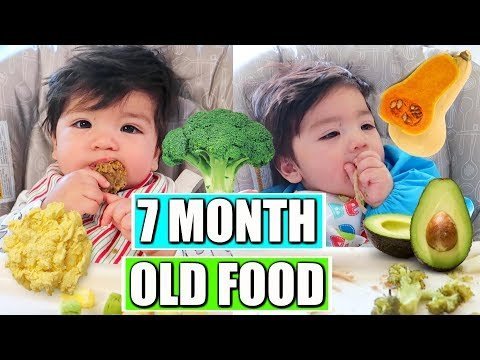 This prevents the potatoes from sticking together in the freezer bag.
This prevents the potatoes from sticking together in the freezer bag. - Once potatoes are partially frozen shift it to the freezer bag and store in the deep freezer.
1. How many times a day should a nine-month-old baby eat?
A nine-month-old baby should eat half a cup of food three to four times daily. In addition, they must also have a healthy snack. Breastfeeding can also be continued during this month (6).
2. Should a nine-month-old still be eating pureed food?
Nine-month-old babies may consume chunky mashed foods. The foods should be soft and chewable. UNICEF recommends feeding finger foods to babies of nine months (6).
3. What can a nine-month-old not eat?
Avoid giving babies foods rich in salt, saturated fats, sugar, honey, and raw or lightly cooked eggs, shellfishes, and meat. As the baby is still teething, refrain from giving them whole nuts, which may also be a choking hazard (7).
By nine months of age, babies are already eating various solid foods in addition to breast milk or formula.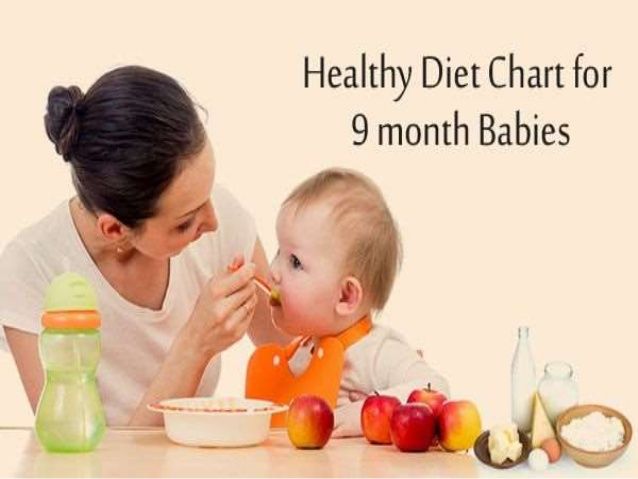 Whether you are feeding them pureed, mashed, or thinly sliced foods for baby-lead weaning, ensure to keep their meals nutritionally well-balanced. While your little one can now eat almost anything that you eat, avoid giving undercooked and unpasteurized foods, honey, salt, and refined sugar. Besides, experiment with different recipes and maintain variety in meals to expose your baby to various food textures and flavors.
Whether you are feeding them pureed, mashed, or thinly sliced foods for baby-lead weaning, ensure to keep their meals nutritionally well-balanced. While your little one can now eat almost anything that you eat, avoid giving undercooked and unpasteurized foods, honey, salt, and refined sugar. Besides, experiment with different recipes and maintain variety in meals to expose your baby to various food textures and flavors.
Key Pointers
- According to WHO, you may continue nursing your baby for more than two years while simultaneously feeding them solid foods.
- The right time to wean your baby may vary depending on their breastfeeding behavior, with most babies starting between 6 to 12 months.
- You may gradually reduce their breastfeeding time while giving appropriate foods to help them adapt easily.
- Provide a nutritious meal with iron-rich food, vegetables, eggs, fruits during the transition, and dishes such as chicken soup for a delicious start.
References:
MomJunction's articles are written after analyzing the research works of expert authors and institutions.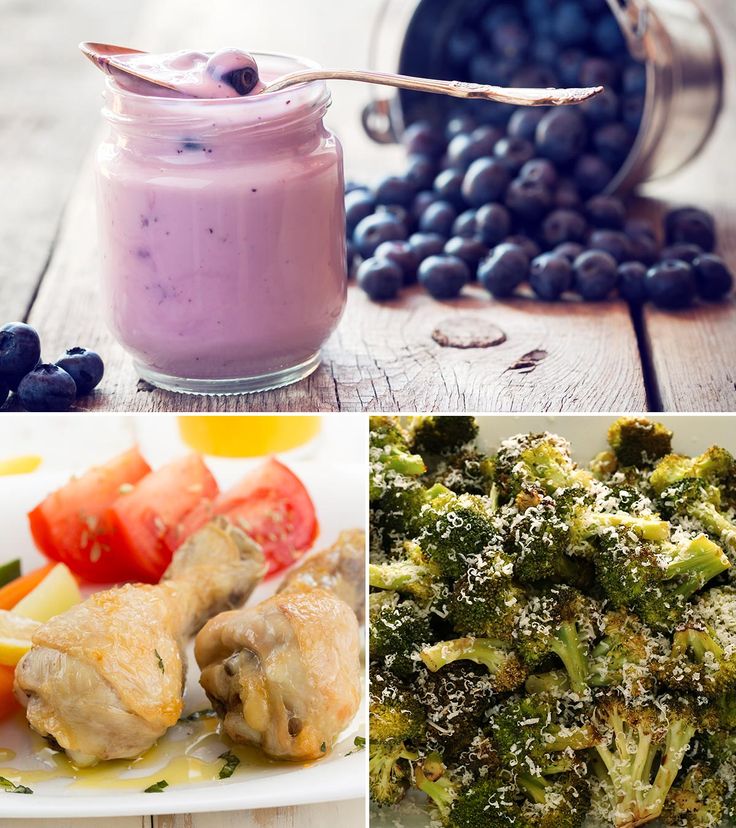 Our references consist of resources established by authorities in their respective fields. You can learn more about the authenticity of the information we present in our editorial policy.
Our references consist of resources established by authorities in their respective fields. You can learn more about the authenticity of the information we present in our editorial policy.
- Frequently Asked Questions (FAQs).
https://www.cdc.gov/breastfeeding/faq/index.htm - Your baby’s developmental milestones at 9 months.
https://www.unicef.org/parenting/child-development/your-babys-developmental-milestones-9-months - Weaning your child from breastfeeding.
https://www.onelovechc.org/weaning_breastfeeding.html - How to Wean Your Baby From Breastfeeding: 3 Do’s + 4 Don’ts.
https://health.clevelandclinic.org/how-to-wean-your-baby-from-breastfeeding-3-dos-and-4-donts/ - Iron.
https://www.cdc.gov/breastfeeding/breastfeeding-special-circumstances/diet-and-micronutrients/iron.html - Feeding Your Baby: 6-12 months.
https://www.unicef.org/parenting/food-nutrition/feeding-your-baby-6-12-months - Foods to avoid giving babies and young children.

https://www.nhs.uk/conditions/baby/weaning-and-feeding/foods-to-avoid-giving-babies-and-young-children/
The following two tabs change content below.
- Reviewer
- Author
Jessica Albert is a passionate writer who seeks to connect with her readers through wit and charm. Her work aims to invoke curiosity and keep the readers engaged through and through. She has prior experience working with magazines and e-commerce establishments as a content marketer and editor. Being a mother herself, she puts all her knowledge into creating content about...
View Profile ›
Moloko Mehlape is a registered dietitian in private practice with special interest in nutrition education, sports nutrition, weight and chronic disease management. She is a philanthropist passionate about making a positive impact in public health through nutrition. Dt. Mehlape has completed extensive formal education and training, and holds qualifications BSc Dietetics (Hons) - Medunsa, MSc Dietetics from the University of. ..
..
View Profile ›
menu for a week, diet for a 9 month old baby with artificial and breastfeeding
Published: 06/20/2020
Reading time: 5 min.
Number of reads: 213084
Author of the article: Ponomareva Yuliya Vladimirovna
Pediatrician, Candidate of Medical Sciences, Allergist-Immunologist
Your baby is 9 months old, and it's time to adjust his nutrition again. The activity of digestive enzymes is already high, teeth erupt in the crumbs, and the volume of the stomach becomes larger, which determines the possibility of increasing the amount of food per feeding and further expanding the diet. What can a child eat at 9months?" - this question very often worries the parents of a grown baby. By this age, the baby's nutrition already includes all the main food groups, and parents should try to diversify the child's menu, expanding the range of his taste sensations. In addition, a varied diet naturally provides a wide range of nutrients. Let's focus on the main food groups that should be on the menu of a 9-month-old baby.
Let's focus on the main food groups that should be on the menu of a 9-month-old baby.
Contents: 9-month-old baby is not enough, so mother's milk should now be no more than a third of the diet. It is best to leave breastfeeding (HF) before bed at night, as well as immediately after waking up in the morning. If the baby is formula-fed, an adapted formula for babies over 6 months of age can be offered at these meals.
See also: Complementary foods and dishesmonths in an amount of at least 200 grams per day. It is a source of minerals, vegetable fibers and organic acids. The assortment of vegetables is very wide, which allows them to be evenly distributed throughout the week. In addition to potatoes, zucchini, cabbage, carrots - traditional vegetable complementary foods for children in the second half of life, pumpkin, beets, spinach and tomatoes can be used in the nutrition of a 9-month-old baby. At this age, if the baby is not worried about excessive bloating, the diet can be diversified with legumes. Start with mashed green peas as a side dish with a meat dish or as an addition to a vegetable soup for dinner.
Start with mashed green peas as a side dish with a meat dish or as an addition to a vegetable soup for dinner.
Fruit and berry complementary foods
Fruits and berries have low nutritional value, but, despite this, they are actively used in the daily diet of a 9-month-old child. Fruits are rich in natural sugars and have an attractive aroma that enhances the palatability of many dishes and is liked by kids. In addition, such food is a source of valuable minerals, organic acids and fiber, which determines its biological significance. It is optimal to include a fruit and berry component 3-4 times a day, it can be a fruit dessert for an afternoon snack, an additional component in the composition of porridge or a curd dish. Every day, a baby can consume up to 90 grams of fruit. By 9 months, it is already permissible for a child to give garden and wild berries, bananas, plums and apricots. Expand the fruit menu consistently and take your time to introduce foods with high allergenic potential, such as citrus fruits, melons, strawberries and exotic fruits.
Grain-based complementary foods
Grain-based foods continue to be the most important source of nutrition and energy for a 9-month-old baby. By this age, the assortment of cereals is increasing, on the basis of which you can cook porridge for your baby. In addition to traditional buckwheat, rice, corn, oat and wheat groats, you can expand the diet with multi-cereal porridge, which may also include rye, barley and millet. When choosing a method for preparing porridge, preference should be given to industrial products. In addition to guaranteed environmental and microbiological safety, the enriched composition provides a daily supply of vitamins and minerals. AT 9months, the child can already eat bread and special baby biscuits without prior dissolution. It is preferable to use wheat bread, no more than 10 grams per day. It is better to dry it before use for easier digestion. Children's cookies are not only a delicacy and a source of energy for the baby, the multi-cereal composition and enrichment with a vitamin and mineral premix favorably distinguishes this healthy food product from traditional bakery products.
Meat food
By the age of 9 months, the baby is already well acquainted with meat complementary foods, and he already has favorite combinations with vegetable and cereal products. What changes await him during this period? The development of the maxillofacial apparatus makes it possible to move from puree-like grinding of meat to various options for meatballs and steam cutlets. In the daily menu, meat complementary foods should be at least 60 grams. In addition to beef and veal, turkey, chicken and rabbit, the baby can be offered dishes based on pork, lamb and horse meat. Meat lure is a traditional lunchtime meal. This feeding accounts for up to 40% of the energy needs of the baby, which is satisfied by a rational combination of vegetables, meat and grains.
Fish
At 9 months, a new food product appears in the baby's diet - fish. In addition to easily digestible protein, it is a valuable source of iodine, fluorine, phosphorus, iron, zinc and magnesium, as well as a number of vitamins. In the diet of young children, ocean fish is primarily used. This variety is rich in polyunsaturated fatty acids, including omega-3, which are extremely important for the functional maturation of the central nervous system and the formation of the retina. However, fish protein is a powerful allergen, so this type of complementary food should be introduced with caution. Start with a teaspoon of fish puree at lunchtime and keep a close eye on changes in your baby's health. In the next two days, do not give the child any new foods so that there is no doubt about the tolerance of the product. Within a month, the amount of fish puree can be gradually increased to 30 grams, but introduced into the menu no more than 1-2 times a week.
In the diet of young children, ocean fish is primarily used. This variety is rich in polyunsaturated fatty acids, including omega-3, which are extremely important for the functional maturation of the central nervous system and the formation of the retina. However, fish protein is a powerful allergen, so this type of complementary food should be introduced with caution. Start with a teaspoon of fish puree at lunchtime and keep a close eye on changes in your baby's health. In the next two days, do not give the child any new foods so that there is no doubt about the tolerance of the product. Within a month, the amount of fish puree can be gradually increased to 30 grams, but introduced into the menu no more than 1-2 times a week.
Sour-milk products
Specialized non-adapted sour-milk drinks (kefir, yogurt, biolact) can be used in a 9-month-old baby's diet. Unlike whole cow's milk, the protein and lactose in them are partially split, which determines their better digestibility, low allergenicity and a slight burden on the kidneys, provided that they consume no more than 200 ml per day. The most preferred choice among the products of this group are drinks based on probiotic cultures, which have a positive effect on their own intestinal microbiota. Cottage cheese is a valuable source of calcium and a complete protein in terms of amino acid composition. AT 9months, it is given to a child in an amount of not more than 50 grams per day in combination with a fruit, vegetable or cereal filler.
The most preferred choice among the products of this group are drinks based on probiotic cultures, which have a positive effect on their own intestinal microbiota. Cottage cheese is a valuable source of calcium and a complete protein in terms of amino acid composition. AT 9months, it is given to a child in an amount of not more than 50 grams per day in combination with a fruit, vegetable or cereal filler.
Fats
Butter is added to prepared meals in the amount of 5 grams per day, improving the taste of prepared complementary foods, as well as increasing their nutritional and energy value. Vegetable oils are rich in polyunsaturated fatty acids, so they should also be present in the baby's daily menu at 5 grams per day as an additive to meat, vegetable or fish dishes.
Drinks
Babies meet their physiological fluid needs through mother's milk or adapted formula. But at 9 months, the consumption of mother's milk is noticeably reduced, so it is necessary that the baby receive other drinks.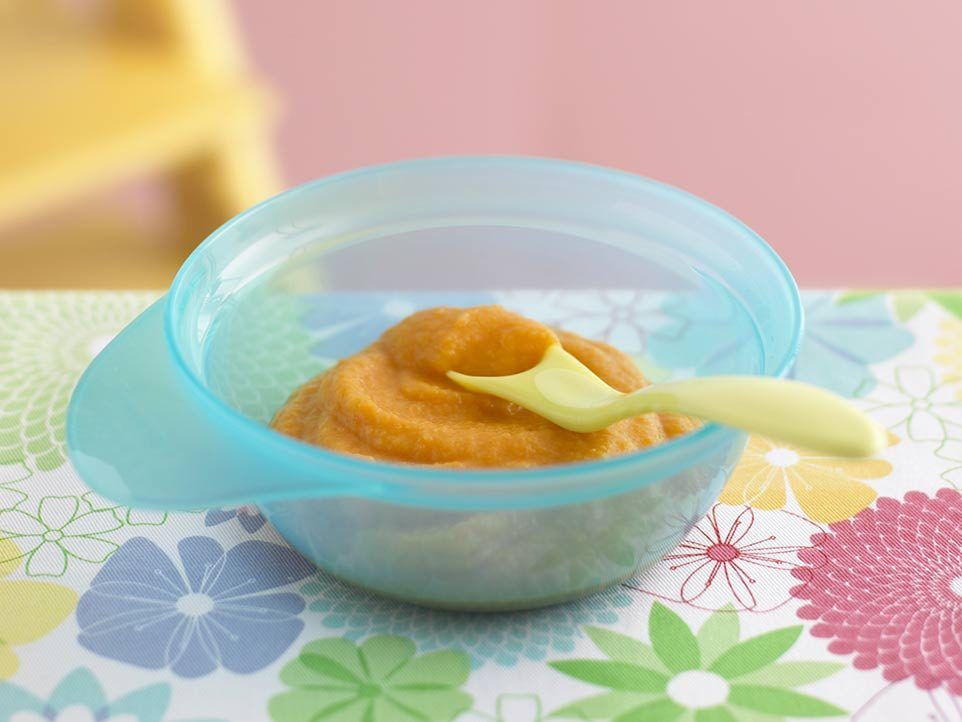 If your child is thirsty, encourage him to drink baby water. The balanced mineral composition and the absence of sugars make it the best option for satisfying fluid needs. Water should be drunk between meals so as not to overload the digestion process. To diversify the diet, you can use specialized children's tea based on extracts of herbs and dried fruits. The pleasant taste of such drinks is combined with a calming and normalizing effect on the digestion process.
If your child is thirsty, encourage him to drink baby water. The balanced mineral composition and the absence of sugars make it the best option for satisfying fluid needs. Water should be drunk between meals so as not to overload the digestion process. To diversify the diet, you can use specialized children's tea based on extracts of herbs and dried fruits. The pleasant taste of such drinks is combined with a calming and normalizing effect on the digestion process.
How to make a diet for the day
The standard diet at 9 months includes 5-6 meals. Each of them is necessary for the even distribution of all nutrients and ensuring vigorous activity during the daytime and a full healthy sleep at night. The table shows an approximate menu for one day for a healthy baby of 9 months.
| Eating | 900 Vegetable puree (zucchini+colored cabbage)/olive oil/yolk | 100/2/2/10 | |||
|
| Meat steamy cutlet | 9000 9000 9000 9000 9000 9000 9000 9000 9000 9000 9000 9000 9000 9000 9000 9000 9000 9000 9000 9000 9000 9000 9000 9000 9000 9000 9000 9000 9000 9000 9000 9000 9000 9000 9000 9000 9000 9000 9000 9000 9000 9000 9000 9000 9000 9000 9000 9000 9000 9000 9000 9000 9000 9000 9000 9000 Dried wheat bread | 50003 | Breast milk/adapted formula | 200 |
Rate the article
(Number of votes: 26, average 4. 8)
8)
Share with friends:
Baby menu at 9 months
6-12 months
Article
5/5 1 reviews
Although breast milk or formula remains the mainstay of infant nutrition at this age, a 9-month-old baby's menu becomes more varied with new complementary foods. The correct diet of the child is the basis of his harmonious development, good health and good mood. But how to organize a diet, what can be given at this age and how much should a child eat at one meal?
8 min. for reading Feb. 17, 2022
The correct diet for a nine-month-old baby includes 5 meals: a day the baby receives liquid food twice and thick food three times. This is due to the fact that mashed potatoes and cereals take longer to digest than milk, so they give the baby a longer energy supply. Feeding is usually carried out at intervals of 4 hours. If the baby asks to eat 2-3 hours after liquid food, offer her a baby snack, fruit or vegetable (in small pieces or in the form of a puree).
This is due to the fact that mashed potatoes and cereals take longer to digest than milk, so they give the baby a longer energy supply. Feeding is usually carried out at intervals of 4 hours. If the baby asks to eat 2-3 hours after liquid food, offer her a baby snack, fruit or vegetable (in small pieces or in the form of a puree).
A 9-month-old baby's daily diet includes many healthy foods and drinks that provide essential nutrients such as vitamins, proteins, carbohydrates, fats and minerals. In addition to milk and infant formula, the following products can be given to a child:
- Fruits and vegetables in the form of puree (apple, pear, cauliflower, etc.)
- Fruit juices and compotes without sugar.
- Meat in various forms.
- Fish.
- Kashi from various cereals.
- Chicken or quail egg yolk.
- Children's fresh cottage cheese.
- Children's low-fat kefir.
- Children's cookies, croutons, bread.
Read also: The baby refuses new products
According to WHO recommendations, by the 9th month, all of the above products should already be on the menu. If something from the food is still unfamiliar to your child, it is recommended to gradually add it to the diet.
If something from the food is still unfamiliar to your child, it is recommended to gradually add it to the diet.
Start with smaller portions and see how your child reacts to the new food. If there is no allergic reaction to the product, you can increase the volume and add it to new dishes. New complementary foods are recommended to be introduced at intervals of 5-7 days. An indicative table for one day will help to create an optimal diet for health. It also shows how much formula or milk the baby should eat per day.
* infant formula.
**Dairy-free porridge should be diluted with breast milk or infant formula given to the baby. Milk porridge is diluted with water.
| I feeding 6 hours | Breast milk or formula for infants with intolerance to cow's milk proteins | 200 ml |
| II feeding 10 hours | Dairy-free porridge* | 180 g |
| Vegetable oil< | about 1 tsp | |
| Fruit puree (apple, pear) | 70 g | |
| III feeding 14 hours | Vegetable puree or pureed soup | 180 g |
| Vegetable oil | about 1 tsp. | |
| Meat puree (rabbit, turkey) | 50 g | |
| Fruit juice | 70 g | |
| IV feeding 18 hours | Fruit puree | 50 g |
| Vegetable puree or dairy-free porridge | 180 g | |
| Vegetable oil | about 1 tsp. | |
| Meat puree | 50 g | |
| V feeding 22 hours | Breast milk or formula for infants with intolerance to cow's milk proteins | 200 ml |
*dairy-free porridge should be diluted with breast milk or it is safe for children with allergies to cow's milk proteins.
** you can eat porridge or vegetables, so you can eat grass - porridge with vegetables.
1st day
| First breakfast | Breast milk or formula |
| Second breakfast | Buckwheat porridge with pumpkin, juice |
| Lunch | Pumpkin steam cutlets, veal puree |
| Snack | Rusks or baby biscuits, yoghurt |
| Dinner | Cauliflower puree |
| Second dinner | Breast milk or formula |
2nd day
| First breakfast | Breast milk or formula |
| Second breakfast | Oatmeal, berry juice |
| Lunch | Steamed fish, rice, fruit compote |
| Snack | Vegetable puree |
| Dinner | Vegetable puree |
| Second supper | Breast milk or formula |
3rd day
| First breakfast | Breast milk or formula |
| Second breakfast | Semolina porridge, quail egg yolk |
| Lunch | Steamed zucchini, boiled veal, apple compote |
| Snack | Pumpkin and apple puree |
| Dinner | Curd casserole with carrots |
| Second supper | Breast milk or formula |
Fourth day
| First breakfast | Breast milk or formula |
| Second breakfast | Rice porridge, fruit puree |
| Lunch | Mashed potatoes or turkey meatball soup |
| Snack | Carrot-apple juice |
| Dinner | Kefir |
| Second supper | Breast milk or formula |
5th day
| First breakfast | Breast milk or formula 9009eight |
| Second breakfast | Oatmeal and apple puree |
| Lunch | Cream soup with chicken and vegetables |
| Snack | Carrot juice |
| Dinner | Cauliflower puree, crackers or bread |
| Second supper | Breast milk or formula |
6th day
| First breakfast | Breast milk or formula |
| Second breakfast | Rice porridge, half yolk (chicken egg) |
| Lunch | Vegetable soup with chicken breast, juice |
| Snack | Baked apple |
| Dinner | Spinach mashed potatoes |
| Second supper | Breast milk or formula |
7th day
| First breakfast | Breast milk or formula |
| Second breakfast | Millet porridge, croutons |
| Lunch | Steamed chicken cutlets, vegetable puree |
| Snack | Apple juice |
| Dinner | Curd with fruits |
| Second dinner | Breast milk or formula |
Parents need to gradually accustom their child to eating thick foods, because now he is moving to a new level of development: more teeth appear, so the baby can now chew food.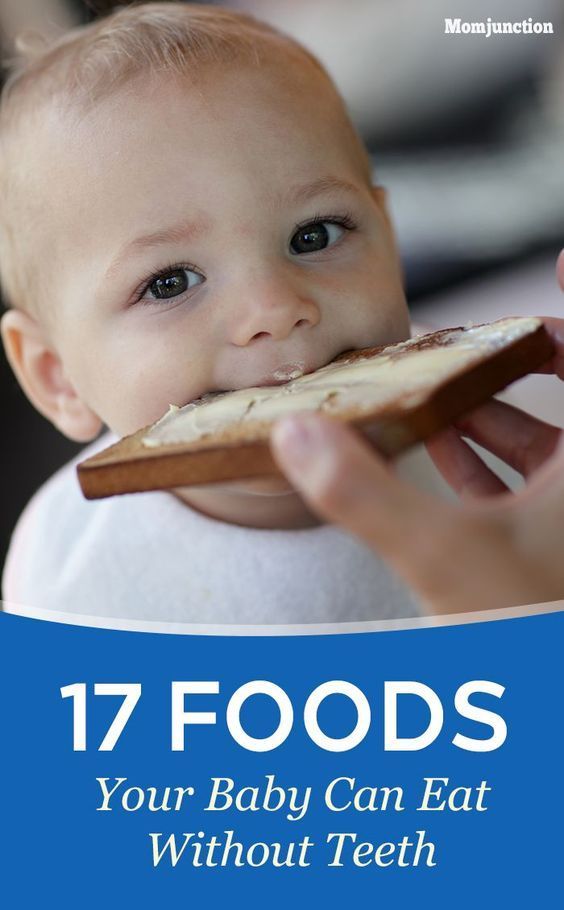 If this is not done in a timely manner, a baby may refuse solid food in a year. Changing the consistency of dishes favorably affects the development of the digestive system.
If this is not done in a timely manner, a baby may refuse solid food in a year. Changing the consistency of dishes favorably affects the development of the digestive system.
No need to grind fish and potatoes in a blender - just put the food on a plate and mash well with a fork. Meat can be offered in the form of meatballs to develop chewing skills. It can be turkey, rabbit, veal, beef, chicken. The norm of meat for one meal is 60-70 g.
It is quite normal if at first large pieces in a dish cause discontent in a child or even a gag reflex - he will soon get used to it. Sometimes it happens the other way around - the baby willingly tries the pieces, but refuses pureed food. Treat your baby with apple slices, bread, crackers or baby snacks. But the meat is still better to grind thoroughly.
At this age, consumption of mother's milk or adapted formula decreases. There are only two feedings per day - in the morning and in the evening. Everything else is "adult" food. Ideally, the baby should sleep through the night and get up at 06:00-07:00. If the little one wakes up at night, it is already possible to gradually wean him from feeding at night (provided that he is gaining weight normally). You can consult with your pediatrician about this.
Ideally, the baby should sleep through the night and get up at 06:00-07:00. If the little one wakes up at night, it is already possible to gradually wean him from feeding at night (provided that he is gaining weight normally). You can consult with your pediatrician about this.
Please note that uneaten food (already cooked) must not be stored and reheated. It is also not recommended to add sugar and salt to the dish.
If you give your child ready-made baby puree, we recommend that you do not feed him immediately from a jar, but pour the right amount onto a plate. In this case, the rest can be stored in the refrigerator for another 24 hours.
Find out more: Baby Portion
Pay attention to the quality of food you cook: appearance, smell and expiration date. It is better to use seasonal vegetables and fruits, and shop in trusted places.
Wash food thoroughly under running water before cooking. You can also use special children's products for washing fruits and vegetables.
All products must be brought to full readiness, and then thoroughly crushed to the desired consistency, so that the baby can comfortably chew small pieces. After eating, wash the dishes with a special detergent.
How to properly feed a 9-month-old baby if he refuses food and does not eat the foods you suggest?
Poor appetite is one of the indicators of a baby's health. The problem may concern the digestive tract, glucose levels, central nervous system. The feeling of hunger appears when the level of sugar in the blood decreases. But for this you need to take breaks between meals. Also, the smell of food affects the appetite - it causes the release of gastric juice.
How to regain your appetite:
- observe the diet;
- develop a delicious menu for a baby at 9 months;
- Serve dishes beautifully and set the table;
- ventilate the room before eating;
- let your baby use cutlery.
See also: Baby doesn't eat well, how to feed?
In order for the baby to eat willingly, he must be in a good mood. Try to avoid stressful and nervous situations, feed him in a calm, comfortable atmosphere.
Try to avoid stressful and nervous situations, feed him in a calm, comfortable atmosphere.
If the baby refuses to eat or eats very slowly, do not rush or force him to eat. Also, do not force the little one to eat foods that he refuses. Otherwise, in the future, he will have a negative attitude towards the feeding process, refuse to eat any food at all. He can even feel sick and vomit only with one kind of food.
Important
Games and cartoons during meals do not really improve appetite. On the contrary, in this way you only teach the baby to eat without noticing the dishes.
With the help of our tips, you can create a menu for a child at 9 months for every day, which will meet the requirements of a healthy diet and preferences of the baby
1. What should not be given to a child at 9 months?
It is not recommended to give cow's milk until the age of one. It contains too much calcium, which overloads the kidneys, and protein, which is poorly digested.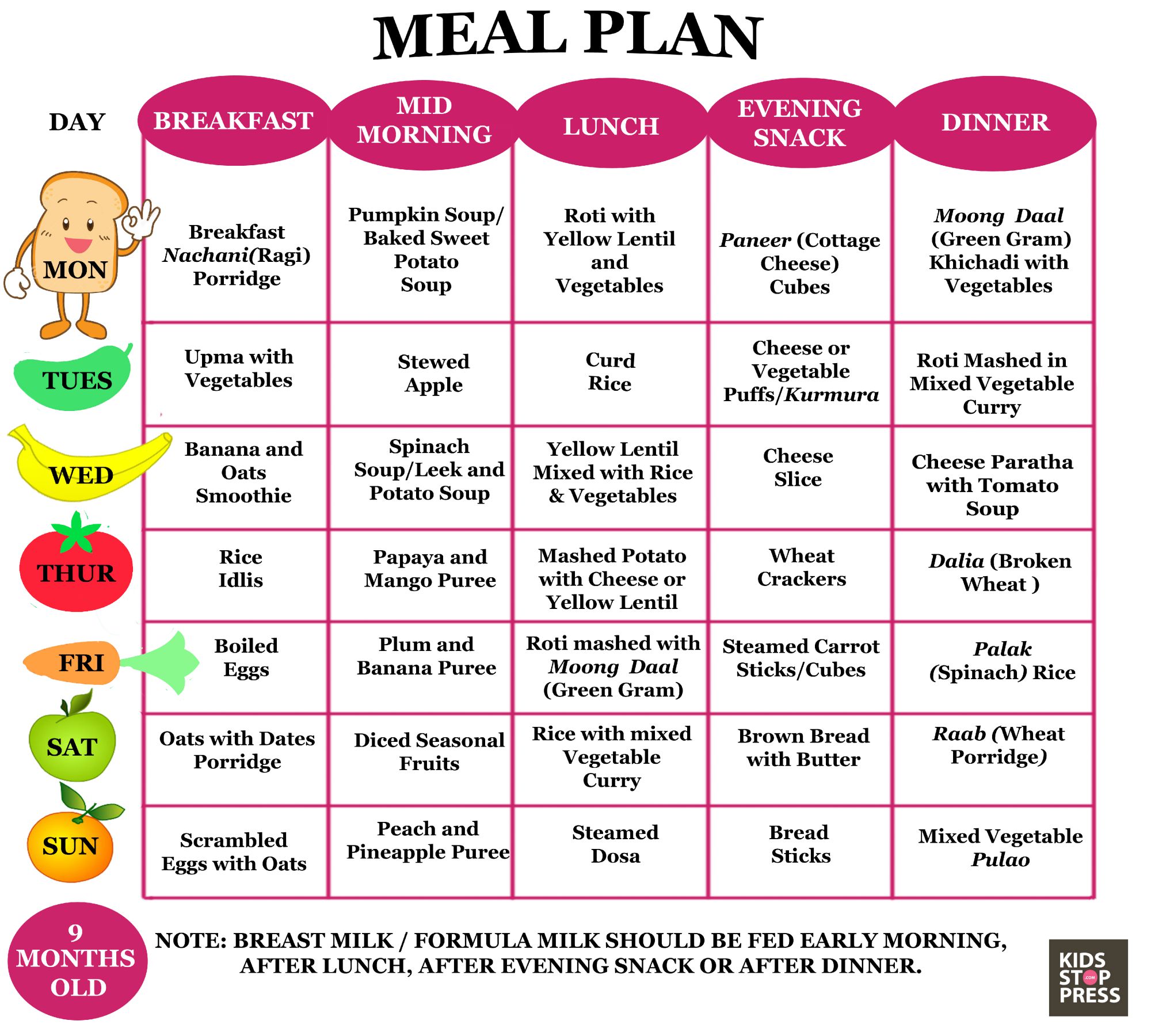

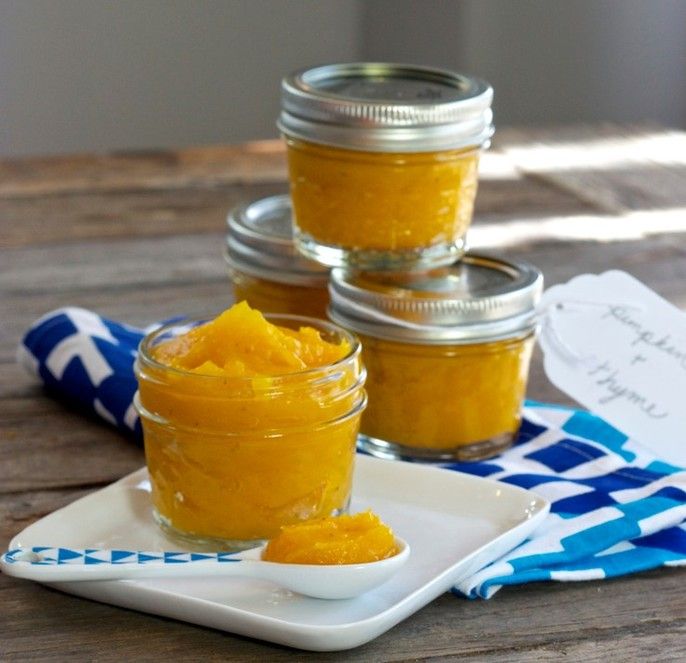 (118 – 177 ml) formula or breastmilk
(118 – 177 ml) formula or breastmilk
